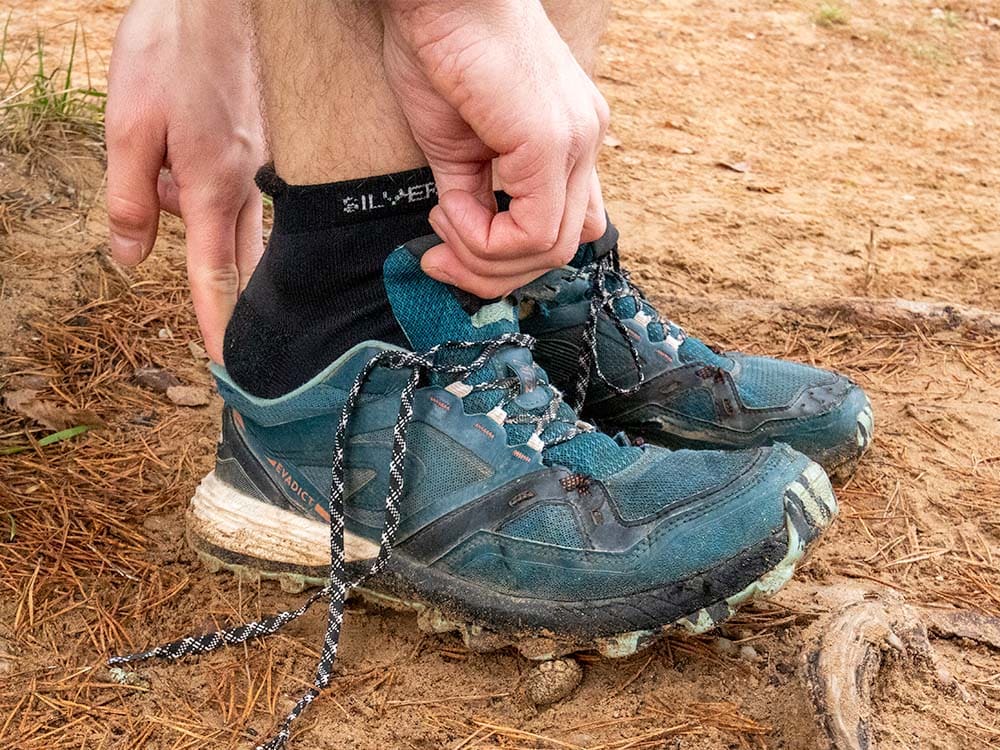I used to deal with this problem where my socks would slip down into my hiking shoes, and I’d have to constantly take off my shoes to readjust my socks. And I know how painfully annoying that is.
Now, I’m not dealing with this problem anymore. And honestly, only one thing changed – I started buying higher-quality hiking socks. It’s probably not the answer you want to hear, but it’s true – only poor-quality or poorly-fitting hiking socks tend to slip down.
Down below, I’ll give you some tips on how to shop for hiking socks that won’t slip down into your shoes.
How To Choose Hiking Socks That Won’t Slip Down Into Your Shoes

- Get socks 1 size below your actual size. Your hiking socks should not feel loose in any part of the sock, but at the same time, they also shouldn’t feel too tight. Usually, a hiking sock that’s 1 size below your actual size (for example, 43 instead of 44) will fit you perfectly. If they feel too loose, return them.
- Get socks that have compression panels. Hiking socks should ideally have some kind of compression, to keep the sock from moving up and down on your feet. Otherwise, the socks can not only slip down but also cause blisters. This is done with compression panels in the middle part of your feet and around the ankle area. However, it’s important to note that winter hiking socks shouldn’t have too much compression, otherwise, they’ll restrict the blood flow of your feet and make them cold.
- Your socks should be at least 1-2 inches above your hiking shoe. As a rule of thumb, your hiking socks have to be longer than your hiking shoes. The longer the better because longer socks will not also reduce their movement, but also protect your legs from overgrown trails when wearing shorts. So with hiking shoes and trail runners, choose no-show, ankle, quarter, or 1/4 socks, and with hiking boots choose crew-height hiking socks.
- Choose no-show socks with ankle-heel flaps. My Silverlight hiking socks have a flap at the top of the heel to keep them from sliding down. This is not necessary if your hiking socks fit you very well and have compression, but it helps if the sock is slightly too big for you.
- Your hiking sock fabric should have some elastane, spandex, or Lycra. Hiking socks with just merino wool and synthetics (polyester, nylon, or acrylic) won’t be elastic enough to stay on your feet without moving. They’ll also be harder to put on, especially if they’re made from synthetics. Ideally, they should have 1-5% elastane, spandex, or Lycra.
- Avoid cotton socks. Cotton socks can get stretched out very easily, and once they do, they’ll slip down into your hiking shoes. In general, cotton should be avoided from hiking socks because it’s also very bad at water resistance, it’s heavy, and it causes blisters. So always go with socks that are made from 30-70% merino wool, 30-70% nylon or polyester, and 1-5% elastane, spandex, or Lycra.
Quick Tip: Add Another Layer Of Socks To Keep Them From Slipping Down
If you purchased good hiking socks but unfortunately, they still slip down or they started slipping over time, you can fix it by wearing another layer of liner socks underneath them. They should be very thin, have no padding, and ideally, be made from synthetics or synthetics/merino wool composite. They should fit you very well and be a bit longer than your outer layer of socks. My personal favorite is the FoxRiver ultra-lightweight liner socks.
Wearing two layers of socks also has other benefits. It reduces blisters, adds more comfort and warmth, and allows you to change only the liner socks when they get damp from sweat, instead of changing the bulkier pair of socks.
Frequently Asked Questions
How can I shrink my socks so that they don’t slip down into my shoes anymore?
If your hiking socks are too large for you, you can try shrinking them down. Essentially, you can do that by exposing them to heat.
To shrink synthetic hiking socks (polyester, nylon, acryl, elastane, spandex, or Lycra), you need to wash them in the hottest and longest possible setting. You can also try boiling them in water for 10 minutes and then drying them in the hottest setting.
To shrink merino wool or regular wool socks, you need to wash them at a bit lower temperature (60 C / 180 F is fine) on the longest possible setting. You can also try boiling some water, letting it cool down a bit, then adding in the socks for about 10 minutes, and then drying the socks in the middle setting.
This solution isn’t permanent, but it might work in the short term.
Why do some socks slide down in my shoes?
From my own experience, hiking socks usually slide down in shoes or boots because of 3 reasons. The first one is that they’re too large for your feet. The second one is because they’re just bad-quality socks in general. All hiking socks should have some form of compression and elasticity. If you’d go hiking with regular socks, most of them would eventually start to slide down your feet because they lack compression. And the third reason is that your boots are too large, and the heel is moving up and down. You can fix this by wearing two layers of socks and using different lacing techniques.
Can I wear no-show socks with hiking boots?
You shouldn’t wear socks that are shorter than your hiking boots. This will most likely cause them to slide down in your boots. Even if they don’t slide down, you might get a blister at the back of your heel because your skin would be directly rubbing against your hiking boot. Instead, your socks should be at least 1-2 inches above the end of your boot – preferably, even longer.
